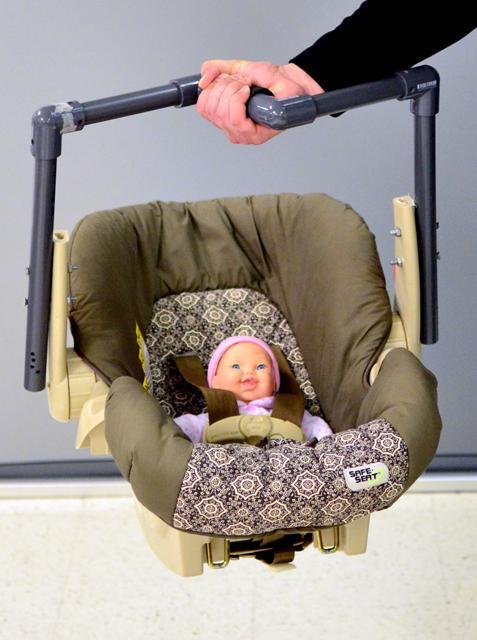
© NCSU Student Media 2012
Michael Clamman, a doctoral student in industrial engineering, holds an infant car seat with a newly designed handle in his right hand. By changing the angle of the handlebar, it makes it easier to carry the infant car seat. Photo by Paul-Gregor Maier
When Michael Clamman had his first child, he thought his time in the gym would be replaced by constant nights of crying, diaper changing and midnight hysterics. While this may have been true, Clamman noticed that his new baby did come with a workout- just not the one he or his body was expecting.
“Carrying a 30-pound weight is not insignificant; in fact our studies have shown that back pain is a common chronic injury in parents due to the constant lifting of infant car seats,” Michael Clamman , a doctoral student in industrial engineering concentrating in ergonomics, said.
Clamman said he wanted to focus on the “lost population,” the parent class. “When I was doing research, I found very little information on ergonomics for parents. This is really something that is getting missed.”
Clamman started improving on the infant car seat (ICS) as a semester project in the fall of 2010. In just four months, he went from identifying a problem to processing the paperwork for a prototype.
“The problem with baby seats today is that the load is just to large for parents to pull out of the car without doing some damage to their back,” said Clamman. “When the parent is lifting a significant load and it’s already placed several feet away from their body, the chances of loosening your grip or losing control goes up significantly.”
This is why Clamman and David Kaber, a professor in industrial engineering, have worked together to change the point of stress from the forearm of the parent, to the bicep, a significantly stronger muscle.
“The data we collected from several studies showed that subjects who were lifting ICS from vehicles tended to favor much larger muscle groups, so we changed the handle of the conventional ICS completely to make it more perpendicular and natural for the parent,” Clamman said.
“There is no way we can change the weight of the baby, that will keep going up; so all we could do is change where the load is applied, and that’s exactly what we did,” Kaber said. “Another interesting thing we did is test specifically the 5 to 20 percentile woman in weight just because it will be tougher for them. If a woman weights 100 pounds, a 30-35 pound ICS is a third of her weight– a substantial proportion.”
There are complications, however. According to Clamman, although tests found that the new ICS makes it easier to actually lift out of the car, carrying the prototype is still awkward.
“The best way to carry an ICS is as close to the body as possible, but the bent handle that makes it severely difficult,” Clamman said. “The best thing to do is limit the time you are lifting the seat anyway, but if you have to, then a stroller add-on would be best.”
Clamman seemed skeptical about putting this prototype into production or applying for a patent, stating that many more variables would be involved in something this sensitive.
“More than anything, I just wanted to prove a point with my research–about how much more can be done for the parent class; if someone wanted to further fund this research I would definitely look into putting this ICS into production,” Clamman said.
Kaber commented on Clamman, saying his point can inspire future design and innovation.
“Michael has been working very hard on this and we are hopeful that some manufacturers or ergonomic practitioners can use our data as a base for future designs because we feel there is a lot of work that can be done on these car seats,” Kaber said.